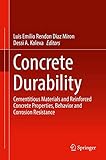Concrete durability : cementitious materials and reinforced concrete properties, behavior and corrosion resistance / Luis Emilio Rendon Diaz Miron, Dessi A. Koleva.
Material type: TextPublisher: New York, NY : Springer Science+Business Media, 2017Description: 1 online resource (viii, 162 pages) : illustrations (some color)Content type:
TextPublisher: New York, NY : Springer Science+Business Media, 2017Description: 1 online resource (viii, 162 pages) : illustrations (some color)Content type: - text
- computer
- online resource
- 978-3-319-55463-1
| Item type | Current library | Call number | Status | Date due | Barcode | |
|---|---|---|---|---|---|---|
| E-Resources | Main Library E-Resources | 620.11 C744 (Browse shelf(Opens below)) | Available | E001669 |
Includes index.
Chapter 1: The Effect of Microorganisms on Concrete Weathering; 1.1 Introduction; 1.2 Chemical and Physical Weathering; 1.2.1 Chemical Weathering; 1.2.2 Physical Weathering; 1.3 Microbiological Weathering; 1.3.1 Microbiological Weathering; 1.3.2 Other Types of Microbiological Weathering; 1.3.3 Sulfur and Limestone Content in Concrete Are the Main Reasons for Weathering Damage; 1.4 Experimental; 1.5 Conclusions; References; Chapter 2: Influence of Sulfur Ions on Concrete Resistance to Microbiologically Induced Concrete Corrosion; 2.1 Introduction; 2.2 Background. 2.2.1 Sulfate Attack on Portland Cement Elements2.2.2 Microbiologically Induced Concrete Corrosion; 2.3 Process Description; 2.4 Experimental; 2.4.1 Concrete Composition; 2.5 Results; 2.6 Discussion; 2.7 Conclusion; References; Chapter 3: The Onset of Chloride-Induced Corrosion in Reinforced Cement-Based Materials as Verified by Embeddable Chloride Sensors; 3.1 Introduction; 3.2 Experimental; 3.2.1 Materials and Specimen Preparation; 3.2.2 Methods; 3.3 Results and Discussion; 3.3.1 Morphology and Composition of the AgCl Layers; 3.3.2 Open Circuit Potential; 3.3.2.1 OCP Development: Steel Rods. 3.3.2.2 OCP Development: Chloride Sensors3.3.3 EIS Response of the Steel Rods; 3.3.3.1 General Considerations; 3.3.3.2 Equivalent Circuits; 3.3.3.3 Quantification of EIS Response; 3.4 Conclusion; References; Chapter 4: The Influence of Stray Current on the Maturity Level of Cement-Based Materials; 4.1 General Introduction; 4.2 Technical Background; 4.2.1 Transport Mechanisms and Diffusion Coefficients; 4.2.1.1 Diffusion Tests; 4.2.1.2 Migration Tests; 4.2.2 Electrical Properties and Maturity Levels; 4.2.2.1 Electrical Resistivity; 4.2.2.2 Methods for Deriving Electrical Resistivity. 4.2.2.3 Maturity Method4.2.3 The Contribution of This Work; 4.3 Experimental Materials and Methods; 4.3.1 Materials; 4.3.2 Sample Designation and Current Regimes; 4.3.3 Methods; 4.3.3.1 Mortar Electrical Resistivity; 4.3.3.2 Compressive Strength; 4.4 Results and Discussion; 4.4.1 Compressive Strength; 4.4.2 Electrical Resistivity; 4.4.3 Ageing Factors Determination; 4.4.4 Diffusion Coefficient; 4.5 Conclusions; References; Chapter 5: Electrochemical Tests in Reinforced Mortar Undergoing Stray Current-Induced Corrosion; 5.1 Introduction; 5.2 Experimental. 5.2.1 Materials and Specimen Preparation5.2.2 Curing Conditions; 5.2.3 Level of Stray Current Regime: Considerations; 5.2.4 Testing Methods; 5.3 Results and Discussion; 5.3.1 Open Circuit Potentials and Polarization Resistance; 5.3.1.1 General Considerations OCP Readings and Rp Values; 5.3.1.2 OCP Values and Curing Age; 5.3.1.3 OCP Evolution Until 28 Days of Age; 5.3.1.4 OCP Records from 28 Days of Age Until the End of the Test (243 days) and Rp Evolution for the 24-h Cured Specimens; 5.3.2 EIS and PDP Response; 5.3.2.1 General Considerations Towards EIS Data Interpretation.
This book describes the newest developments in the creation of concrete using smart additives and supplementary cementitious materials as well as methods, technology and novel admixtures to monitor, evaluate and control steel corrosion in reinforced concrete. Industry experts and research specialists explain the structural, physical, and chemical properties of various types of concrete and its applications. They detail the characteristics preferred for manufacturing specific types of concrete. The book chapters also focus on the electrochemical state of the steel reinforcement in view of steel corrosion and corrosion control. The book encompasses main aspects as follows: Characterizes supplementary cementitious materials used for making concrete; Details the properties of concrete and the components, essential for concrete manufacturing including Portland cement, calcium sulfate, fly ash, and cupola slag; Explains the necessary treatments for the preparation of concrete during the manufacturing process. Describes the major durability-related challenge for reinforced concrete structures i.e. chloride-induced steel corrosion, in view of sensors and sensor technology for early corrosion detection. Defines stray-current induced corrosion and the consequences for both steel and concrete bulk matrix. Illustrates the potential of hybrid nano-materials to affect both steel and concrete, targeting corrosion control and superior performance of reinforced concrete structures. Targets dissemination of fundamentally substantiated mechanisms and verification of innovative applications, in view of bringing confidence for industrial utilization of novel solutions or practices in civil engineering.
There are no comments on this title.

